In Skid Row, a 19-story residential tower for homeless people will offer gym, cafe, art studio
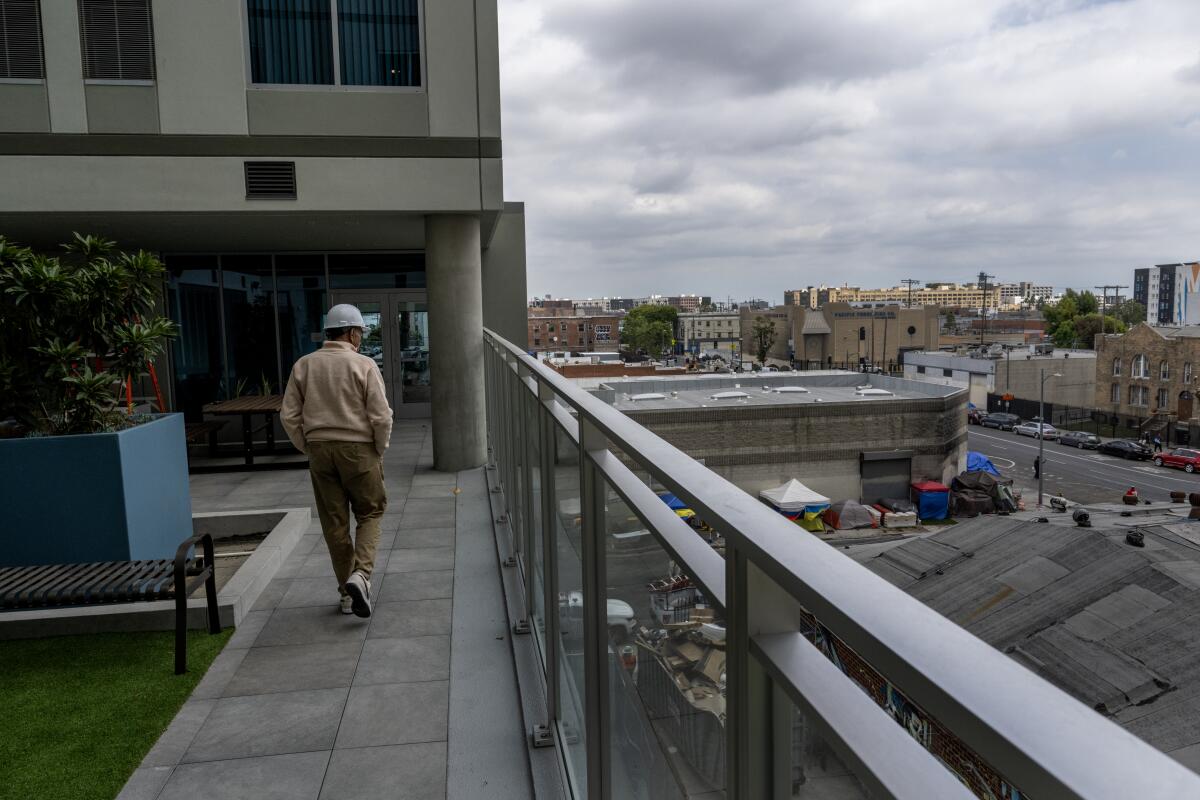
From the courtyard balcony on the 19th story of the new residential tower, Skid Row seems small and distant below.
Its barely visible tents and shanties melt into vistas of the downtown skyline and San Gabriel Mountains to the north and the flat expanse of city south to the sea. Even the row of buildings on San Pedro Street that form the core of Skid Row’s service institutions — the Midnight Mission, Union Rescue Mission, LAMP Community, JWCH Institute, the Cobb residences and the 11-story Weingart Center — are reduced to rooftop outlines.
And that’s the idea. The 278-unit tower, due to open this month, is meant to be a self-contained environment that will insulate its formerly homeless residents from the squalor and hopelessness around them and, at the same time, elevate the neighborhood.

“We’re trying to make our little corner of the world look and feel a little better,” said Kevin Murray, president and chief executive of Weingart Center Assn. and mastermind of the project.
Murray’s grand plan will take its first step this month when Weingart begins leasing the first of three high-rise buildings that will wrap around the nonprofit’s headquarters at 6th and San Pedro streets.
The second tower, with 302 rooms, is now rising on the south side of 6th Street and is scheduled to open in about 18 months. A third, 104-unit tower is in the planning phase.
Murray, a former state senator who has led Weingart since 2011, departed from conventional homeless housing practice when he launched the project in 2017 in collaboration with Carlsbad-based affordable housing developer Chelsea Investment Corp. At the time, Skid Row housing and service providers were looking outward, building housing in the Valley, Westlake, Hollywood and South L.A. in hopes of decentralizing their work on Skid Row.
Not only did Murray bet on Skid Row, he bet big. The tower will be the largest permanent supportive housing project in the city with more than four times more units than the average in the city’s $1.2-billion Proposition HHH program.
Murray said Weingart was not constrained by the cap on development fees that tend to keep projects funded by tax credits under 75 units.
“We aren’t in it for the developer fee, so we said let’s just build the biggest thing we can,” he said. “You just can’t fix the problem at 50 units a pop.”
The scale offered space for amenities that don’t usually come with housing for homeless people.
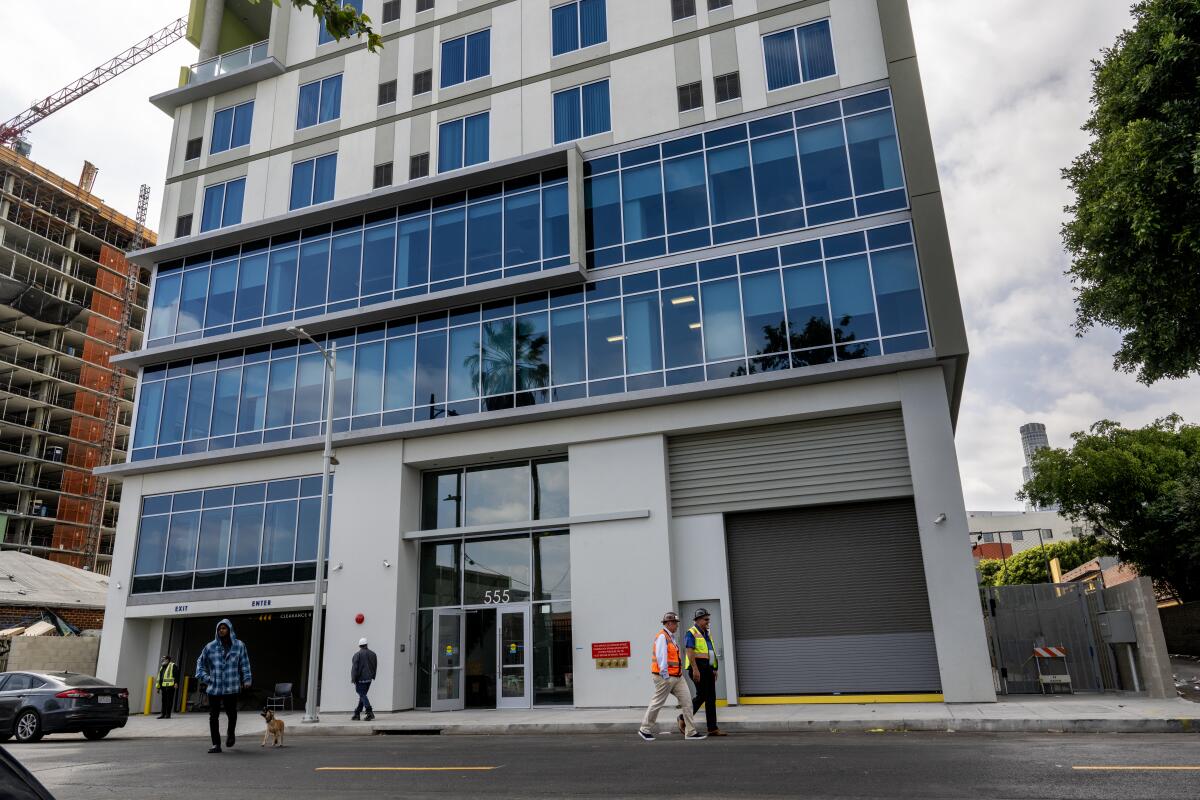
Besides a floor of offices for case workers, conference rooms and property managers, the tower boasts a gym, an art room, a soundproofed music room, a computer room/library, a TV lounge, six common balconies, four of them with dog runs, and a ground floor cafe with a two-story glass wall facing a courtyard.
The music and art rooms were included to facilitate programming by outside organizations.
“When I talk to arts educators, they always have trouble finding a space,” Murray said.
A commercial kitchen on the second floor will serve Weingart’s 600-bed shelter next door. The current kitchen, in a one-story building on San Pedro Street, will be demolished to make way for the future third tower.
Residents can bring food from outside, cook in their own rooms or buy food prepared in the kitchen.
“We will offer people a meal plan, frankly, because we have a kitchen,” Murray said.
Each room — 228 studios and 50 one-bedroom apartments — has its own TV, and the cafe will also bring residents together on movie nights.
The $165-million project will receive permanent financing from Proposition HHH, state housing funds and $56 million in state tax credits. The cost, at just under $600,000 per unit, puts it at the high end of Proposition HHH projects but well below the most expensive.
The architecture is fairly typical. It would blend in on much of Wilshire Boulevard. Materials, from hallway floors to kitchen cabinets, are durable but not flashy.
The concept is to have a campus that is inward focused — encouraging its 700 or so residents, when all three buildings are completed, to isolate from the influences outside, while also bringing a flavor of the Westside to the rest of Skid Row.
On the Westside, Murray said, balconies are included to keep people from hanging out in front of their buildings.
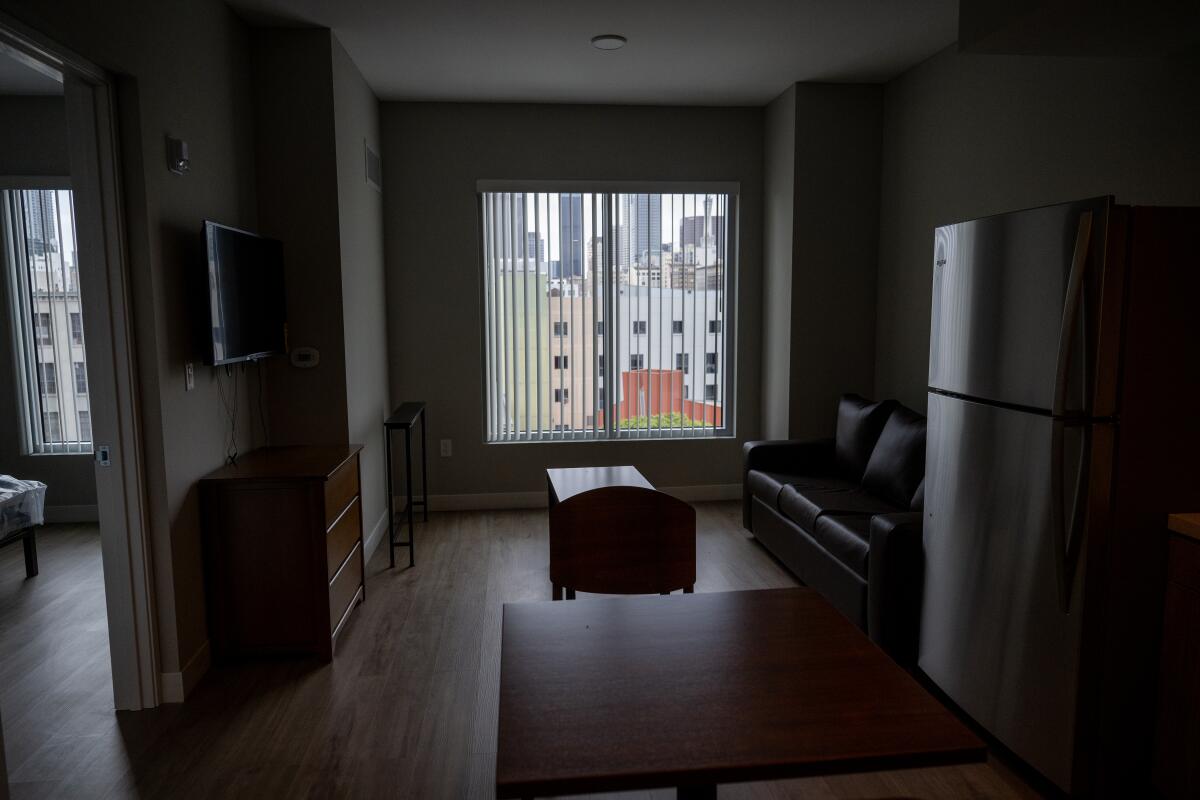
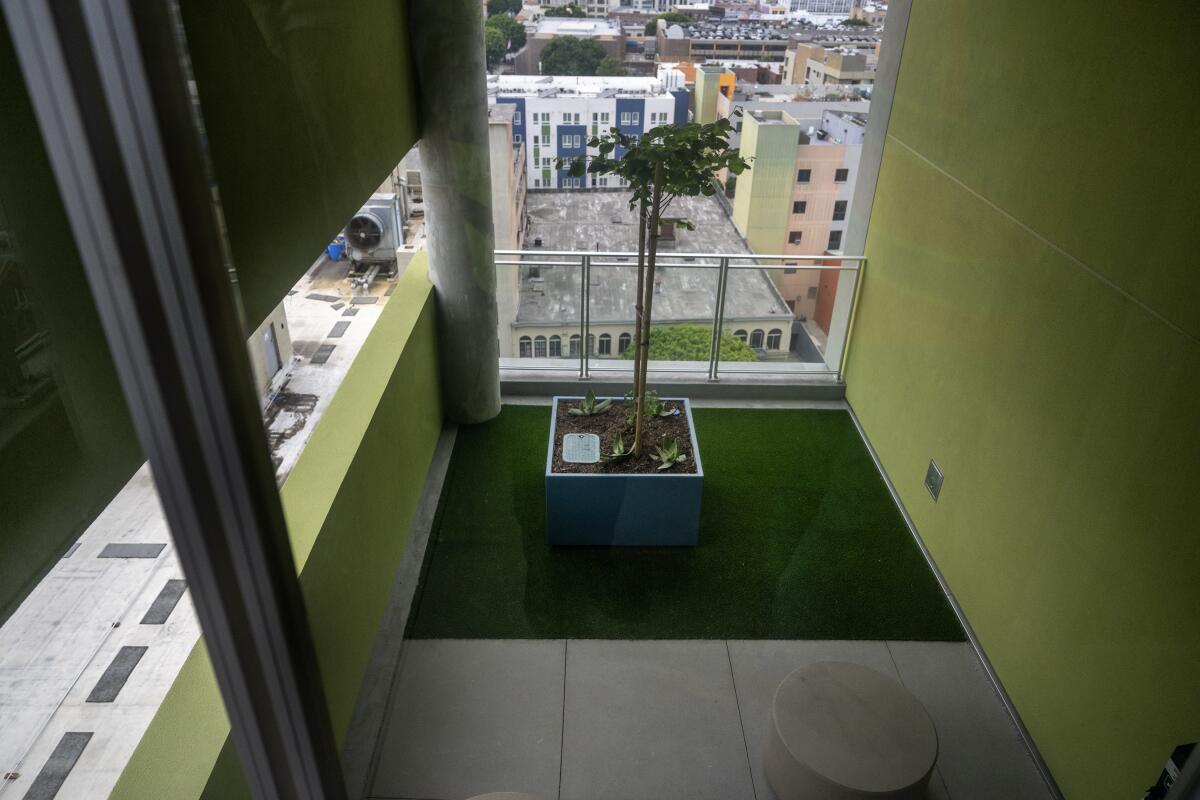
“Down here, it’s so you don’t have to go out into Skid Row in order to walk your dog.”
The towers are a hit with a variety of downtown interests.
The Central City Assn. of Los Angeles “is a long-standing supporter of the Weingart Tower as a state-of-the-art project that will house hundreds currently experiencing homelessness,” said Nella McOsker, president and chief executive of the association.
She sees it as one component of the concept that “housing at all income levels is key to a vibrant and dynamic residential population in downtown L.A.”
Estela Lopez, executive director of the Downtown Industrial District BID, said she sees concentrating extreme poverty as bad policy and favors affordable and market rate construction, such as the redevelopment of the Jordan Downs housing project in Watts.
“Having said that, the Weingart represents a campus of hope for those souls who will reside there,” she added.
Lopez said she has joined Murray in advocating for amenities such as a grocery store and pharmacy for Skid Row‘s elderly, ill and disabled residents.
Pete White, executive director of the Skid Row advocacy group Los Angeles Community Action Network, said he sees the towers as “one important feature of what a stabilized Skid Row can look like. We 100% need more housing in Skid Row.”
White does not see the towers as an island.
“I see the tower as providing a great need, a great housing need in Skid Row and a design that says poor residents are worthy.”
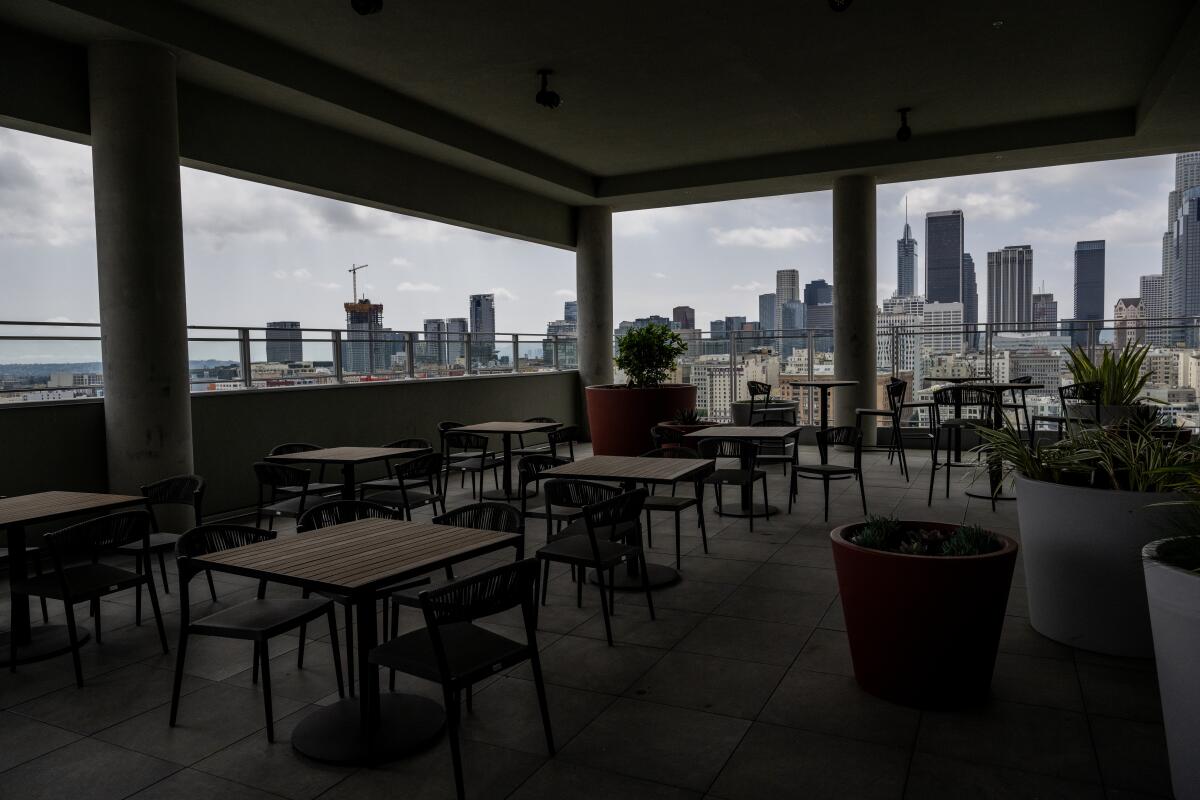
That’s the sentiment at the core of Murray’s plan. As a counterpoint, he points to the Cobb, built by the now defunct Skid Row Housing Trust in 2009.
“I went in the Cobb,” he said, looking down at the 72-unit building on the opposite corner. “It’s designed like a dark little hovel. Who would want to live like that?”
Among the unusual aspects of the Weingart building is what Chelsea chief development officer Jim Anderson calls “destination control.” Like in large commercial buildings, elevators have no buttons. Residents will activate them with key cards that give access only to their own floor and common areas.
Those don’t include the 19th floor, which will house Weingart administration. The sweeping 19th-story balcony will be used for receptions and fundraisers.
More to Read
Sign up for Essential California
The most important California stories and recommendations in your inbox every morning.
You may occasionally receive promotional content from the Los Angeles Times.











